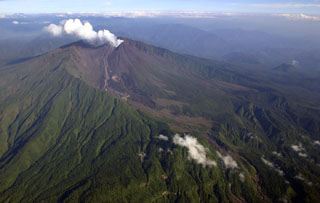Report on Reventador (Ecuador) — 21 April-27 April 2010
Smithsonian Institution / US Geological Survey
Weekly Volcanic Activity Report, 21 April-27 April 2010
Managing Editor: Sally Sennert.
Please cite this report as:
Global Volcanism Program, 2010. Report on Reventador (Ecuador) (Sennert, S, ed.). Weekly Volcanic Activity Report, 21 April-27 April 2010. Smithsonian Institution and US Geological Survey.
Reventador
Ecuador
0.077°S, 77.656°W; summit elev. 3562 m
All times are local (unless otherwise noted)
The IG reported that on 20 April scientists conducting an overflight of Reventador saw steam-and-gas emissions. They also observed an explosion generate a pyroclastic flow that traveled 200 m down the S flank. Deposits from previous pyroclastic flows were seen on the same flank. Explosions generated steam-and-gas plumes with low ash content during 20-22 April. Weather clouds prevented views of the volcano in satellite imagery on 23 April, although a pilot reported that an ash plume rose to an altitude of 4.9 km (16,000 ft) a.s.l. On 26 April a steam-and-ash plume rose 500 m above the crater.
Geological Summary. Volcán El Reventador is the most frequently active of a chain of Ecuadorian volcanoes in the Cordillera Real, well east of the principal volcanic axis. The forested, dominantly andesitic stratovolcano has 4-km-wide avalanche scarp open to the E formed by edifice collapse. A young, unvegetated, cone rises from the amphitheater floor to a height comparable to the rim. It has been the source of numerous lava flows as well as explosive eruptions visible from Quito, about 90 km ESE. Frequent lahars in this region of heavy rainfall have left extensive deposits on the scarp slope. The largest recorded eruption took place in 2002, producing a 17-km-high eruption column, pyroclastic flows that traveled up to 8 km, and lava flows from summit and flank vents.
Sources: Instituto Geofísico-Escuela Politécnica Nacional (IG-EPN), Washington Volcanic Ash Advisory Center (VAAC)

